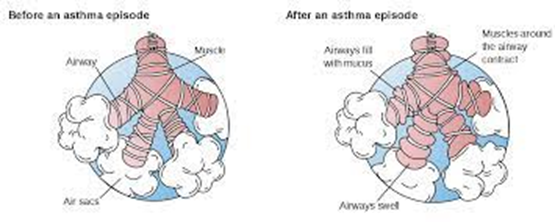A nurse is caring for six clients. Which of the following clients are at risk for developing peripheral neuropathy (PN)?
(Select All that Apply.)
The client admitted with diabetic ketoacidosis (DKA)
The client admitted with sleep apnea
The client admitted with a hypertensive crisis
The client admitted for an exacerbation of Systemic Lupus Erythematosus (SLE)
The client admitted with untreated tuberculosis
The client admitted with cirrhosis secondary to chronic alcohol use
Correct Answer : A,D,E
Choice A Reason:
The client admitted with diabetic ketoacidosis (DKA) is correct. Diabetes is a common cause of peripheral neuropathy, particularly if poorly controlled. Diabetic ketoacidosis (DKA) is a severe complication of diabetes characterized by high blood sugar levels and ketone accumulation. Prolonged uncontrolled diabetes can lead to nerve damage and peripheral neuropathy.
Choice B Reason:
The client admitted with sleep apnea is incorrect. Sleep apnea is a sleep disorder characterized by pauses in breathing or shallow breathing during sleep. While sleep apnea itself is not typically associated with peripheral neuropathy, underlying conditions such as obesity or diabetes, which are risk factors for sleep apnea, can also increase the risk of peripheral neuropathy.
Choice C Reason:
The client admitted with a hypertensive crisis is incorrect. Hypertension (high blood pressure) is not directly associated with peripheral neuropathy. However, poorly controlled hypertension can lead to vascular complications and contribute to conditions such as atherosclerosis, which may indirectly increase the risk of peripheral neuropathy.
Choice D Reason:
The client admitted for an exacerbation of Systemic Lupus Erythematosus (SLE) is correct. Systemic Lupus Erythematosus (SLE) is an autoimmune disease that can affect various organs and tissues, including the peripheral nerves. Peripheral neuropathy can occur as a complication of SLE, particularly in cases of active disease or as a result of certain medications used to treat SLE.
Choice E Reason:
The client admitted with untreated tuberculosis is incorrect. Tuberculosis (TB) is a bacterial infection caused by Mycobacterium tuberculosis. While TB itself is not typically associated with peripheral neuropathy, certain medications used to treat TB, such as isoniazid, can cause peripheral neuropathy as a side effect.
Choice F Reason:
The client admitted with cirrhosis secondary to chronic alcohol use is correct. Chronic alcohol use and cirrhosis can lead to various neurological complications, including peripheral neuropathy. Alcohol-related peripheral neuropathy often presents with sensory symptoms such as tingling, numbness, and pain in the extremities.
Nursing Test Bank
Naxlex Comprehensive Predictor Exams
Related Questions
Correct Answer is C
Explanation
Choice A Reason:
Decreased mucus production contributes to airway constriction: This statement is incorrect. Bronchospasm does not decrease mucus production; instead, it primarily affects the smooth muscles surrounding the bronchioles, leading to their constriction and narrowing of the airways. Increased mucus production, often accompanied by inflammation, can contribute to airway obstruction in conditions like asthma.
Choice B Reason:
Inflammation is reduced due to airway diameter: This statement is incorrect. Bronchospasm typically occurs in the setting of inflammation in conditions such as asthma. Constriction of the airways during bronchospasm exacerbates the inflammation and can further narrow the airways, leading to symptoms such as wheezing and dyspnea.
Choice C Reason:
Bronchospasm occurs when there is inflammation, edema, and excess mucus: This statement is partially correct. Bronchospasm often occurs in the presence of inflammation, edema, and excess mucus production, as seen in conditions like asthma. These factors contribute to airway hyperresponsiveness, leading to bronchospasm and airway narrowing.
Choice D Reason:
Airway obstruction occurs due to thinning mucus: This statement is incorrect. Airway obstruction in conditions like asthma is primarily due to bronchospasm, inflammation, and excessive mucus production, rather than thinning mucus. Thinning of mucus would not typically contribute to airway obstruction.

Correct Answer is D
Explanation
Choice A Reason:
Hypertension is not typically associated with heterotopic ossifications. However, it may occur in individuals with spinal cord injuries (SCI) due to autonomic dysreflexia, a condition characterized by an exaggerated sympathetic response to stimuli below the level of injury. Autonomic dysreflexia can lead to a sudden increase in blood pressure, which, if left untreated, can result in complications such as stroke or seizure. However, hypertension is not directly related to heterotopic ossifications.
Choice B Reason:
Bradycardia is also not typically associated with heterotopic ossifications. Like hypertension, bradycardia may occur in individuals with SCI due to autonomic dysreflexia. Autonomic dysreflexia can lead to a sudden increase in blood pressure and a reflex bradycardia in response to the increased sympathetic outflow. However, bradycardia is not directly related to heterotopic ossifications.
Choice C Reason:
Fecal impaction is a potential complication of spinal cord injury (SCI) due to impaired bowel function, but it is not directly related to heterotopic ossifications. SCI can disrupt normal bowel motility and result in neurogenic bowel dysfunction, leading to symptoms such as constipation, fecal impaction, and bowel obstruction. However, fecal impaction is not specific to heterotopic ossifications.
Choice D Reason:
Arthralgia is correct. Heterotopic ossifications (HO) involve the abnormal formation of bone in soft tissues around joints, muscles, tendons, or ligaments. When HO occurs around joints, it can lead to symptoms such as pain, swelling, and decreased range of motion, collectively known as arthralgia. Therefore, arthralgia is a common finding associated with heterotopic ossifications in individuals with spinal cord injuries.
Whether you are a student looking to ace your exams or a practicing nurse seeking to enhance your expertise , our nursing education contents will empower you with the confidence and competence to make a difference in the lives of patients and become a respected leader in the healthcare field.
Visit Naxlex, invest in your future and unlock endless possibilities with our unparalleled nursing education contents today
Report Wrong Answer on the Current Question
Do you disagree with the answer? If yes, what is your expected answer? Explain.
Kindly be descriptive with the issue you are facing.
